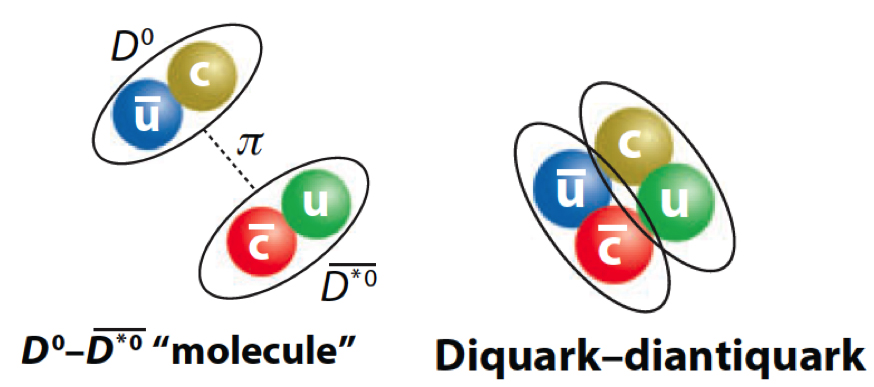X(3872): A mysterious particle from the early days of the universe
At the very beginning of the universe, it was still very, very hot. At that time, matter did not consist of the particles we know today, such as protons or neutrons. If it becomes too hot for these particles (generally called hadrons), they start to boil and decompose into their components, like water becomes steam. For this it must be at least 1.7 trillion Kelvin (3 trillion Fahrenheit) hot, the so-called Hagedorn temperature. The particles which then float in the soup, the plasma, are on the one hand quarks, on the other hand gluons. The gluons are normally the glue that holds the quarks together in the hadrons. In the quark-gluon plasma, however, they are free – as are the quarks.
If researchers want to study the very early history of the universe, they have to figure out how the quarks and gluons behave in their plasma. This is not so easy, because one needs a lot of energy to produce such a plasma. This is tried for example in particle accelerators. However, there is another problem: There are so many reactions that it is difficult to isolate individual ones. Just try to catch a single water vapor molecule from the steam in a sauna! Physicists at CERN’s Large Hadron Collider have now succeeded in doing something quite comparable. From 13 billion (1.3 * 109) collisions, in which in each case over a quadrillion (1015) short-lived particles were created, they detected a three-digit number of particles of the type X(3872). For comparison: one liter of air contains about 2.5*1019 particles. The researchers accomplished the task using a machine learning algorithm that they trained on the specific decay patterns of X(3872).
But why this effort for a particle that has been known since 2003 and that decays extremely fast at the same time? What fascinates the researchers most about X(3872) is its unknown nature, symbolized by the X sign (the 3872 is the mass in MeV/c2). Indeed, it does not fit into the picture that researchers have so far formed of quarks and their behavior. Two possibilities come to mind for X(3872), both of which are very exciting. First, it could be some kind of molecule of D0 and anti-D0* mesons. Since these mesons contain the very rare charm quark, the researchers call the molecule from it “charmonium”, just as a compound of electron and positron is called “positronium”. However, the fact that quarks form such bonds with each other in the quark-gluon plasma would be an unexpected behavior. Just as unexpected, but according to the current state of knowledge even a bit more probable, is the fact that we have here a so-called tetraquark before us. From the normal world one knows at most connections of three quarks (baryons) or of two quarks (mesons). The first confirmation of the existence of tetraquarks did not occur until 2016 at CERN. To be able to explore the exact properties of the X(3872), one needs as many copies of it as possible. Physicists are now well on the way to achieving this.
It would now be interesting to find out whether the glue in the quantum soup sometimes clumps together – whether there are also connections between the gluons, which are quite appropriately called glueballs. That would be another sensation, because photons (particles of light), which are comparable to gluons in the normal, cold world, do not have this ability. In 2021, there were first indications – also from CERN – of a glueball consisting of three gluons, the “odderon”. A two-gluon compound would be called “pomeron”.
